Mechanical Properties of Corroded Reinforcement
Abstract
:1. Introduction
- -
- changing the purpose of the building—other loads must be considered, which may be even greater than originally considered;
- -
- verification of the feasibility of rebuilding or the possibility of extending the service lifetime of the building;
- -
- reliability check (e.g., for seismic effects, increased load) required by state authorities, insurance company, owner, etc.;
- -
- detection of structural failures due to time-dependent loading (e.g., corrosion, fatigue, defects or damaged parts, increase in deformations, increased vibrations, etc.) or extraordinary loading [14].
2. Reinforcement Production Method
2.1. Cold Forming—Cold Rolled Steel/CRS
2.2. Hot Forming—Hot Rolled Steel/HRS
2.3. Thermal Refinement/Controlled Cooling from Rolling over Temperature, TEMPCORE®, TMT
3. Corrosion
4. Experimental Study Program
4.1. Cold Rolled Reinforcement ϕ6
4.2. The Effect of Corrosion on Reinforcement ϕ6
4.3. Hot-Rolled Reinforcement with Controlled Cooling ϕ10 (Thermal Refinement, TMT)
- -
- 4 pcs (samples) without modifications,
- -
- 3 pcs (samples) without ribs, 3 pcs ϕ8 mm, 3 pcs ϕ7.24 mm, 3 pcs ϕ6.35 mm, 6 pcs ϕ5 mm, 3 pcs ϕ4 mm (total 21 samples)—those samples were standardly-treated samples to smaller diameters to verify whether the cross-sectional strength is constant or changes.
4.4. The Effect of Corrosion on Reinforcement ϕ10
5. Evaluation of Results and Discussion
- Z—samples without modification (without simulating pitting corrosion), length 120 mm between jaws in hydraulic jack—3 pcs,
- N11—samples with a diameter of 11 mm (turned in a lathe from 12 to 11 mm), length of processing Lc = 77 mm (simulating surface corrosion)—according to the standard [74],
- N10—samples with a diameter of 10 mm (turned in a lathe from 12 to 10 mm), length of processing Lc = 70 mm (simulating surface corrosion)—according to the standard [74],
- N8—samples with a diameter of 8 mm (turned in a lathe from 12 to 8 mm), length of processing Lc = 56 mm (simulating surface corrosion)—according to the standard,
- V11—the sharp notch so that the inner diameter is 11 mm (simulating pitting corrosion), the distance between the jaws was 120 mm,
- V10—the sharp notch so that the inner diameter is 10 mm (simulating pitting corrosion), the distance between the jaws was 120 mm,
- V8—the sharp notch so that the internal diameter is 8 mm, the width of the notch was 4 mm (simulating pitting corrosion), and the distance between the jaws was 120 mm.
6. Conclusions
- -
- It has been proven that there is a difference in the mechanical properties of the cross-section reinforcements produced by different production methods (cold rolled and hot rolled thermal refinement); thus, from the point of view of recalculation of the existing structure attacked by corrosion, it is necessary to know how the resistance of the reinforcement can change (tensile strength—yield strength) over time due to corrosion, which means that it is necessary to find out how the reinforcement was manufactured, or to verify this fact by tests on samples.
- -
- It was confirmed that in the case of the cold rolled reinforcement, the mechanical properties after the cross-section are approximately the same (constant),
- -
- In the case of reinforcement produced by the Tempore method (thermal refinement), it was confirmed that in the core (ferrite-pearlite) there is an area with the lower yield strength and tensile strength, and that the surface layer has high yield strength and tensile strength.
- -
- Corrosion of the reinforcement in the case of the cold formed reinforcement is not so important for changing the mechanical properties; however, in the case of the thermally refined reinforcement it has a significant effect—corrosion of the reinforcement causes a decrease in the yield strength and tensile strength because it first corrodes the surface layer, which has a higher yield strength and tensile strength.
- -
- It has been proven that the notches that are developed as a result of corrosion have a significant effect on the spatial tension in the reinforcement at the place of the notch and increases the values of the yield strength and the tensile strength of the reinforcement.
- -
- If it was necessary to determine the mechanical properties of the reinforcement as accurately as possible, then it is necessary to determine the cross-sectional area of the reinforcement as accurately as possible—it is recommended to take samples of the reinforcement from the structure and standard-treat them (standardly-treated samples) to obtain the exact area of the reinforcement Amin and thus determine as accurately as possible the yield and tensile strength.
- -
- If it is not possible to take samples (to avoid the failure of reinforced concrete (RC) member), it is necessary to find the places with the smallest diameter ϕmin and determine Amin from it, and if it is reinforcement produced by Tempcore method, it is necessary to reduce the yield strength and the tensile strength to correspond to the core yield strength.
Author Contributions
Funding
Institutional Review Board Statement
Informed Consent Statement
Data Availability Statement
Acknowledgments
Conflicts of Interest
References
- Kala, Z. Global sensitivity analysis of reliability of structural bridge system. Eng. Struct. 2019, 194, 36–45. [Google Scholar] [CrossRef]
- Benko, V. Reliability of Building Structures (According to Eurocodes), 1st ed.; SKSI: Bratislava, Slovakia, 2010; p. 86. (In Slovak) [Google Scholar]
- Kala, Z. Sensitivity Analysis in Probabilistic Structural Design: A Comparison of Selected Techniques. Sustainability 2020, 12, 4788. [Google Scholar] [CrossRef]
- Prokop, J.; Vican, J. Comparison of beam-column resistance according to European Standards. Transp. Res. Procedia 2019, 40, 883–890. [Google Scholar] [CrossRef]
- Krejsa, M.; Koubova, L.; Flodr, J.; Protivinsky, J.; Nguyen, Q.T. Probabilistic prediction of fatigue damage based on linear fracture mechanics. Frat. Integrita Strutt. 2017, 11, 143–159. [Google Scholar] [CrossRef] [Green Version]
- Bobalo, T.; Blikharskyy, Y.; Kopiika, N.; Volynets, M. Serviceability of RC Beams Rein-forced with High Strength Rebar’s and Steel Plate. In Proceedings of Advances in Resource-Saving Technologies and Materials in Civil and Environmental Engineering (CEE 2019); Lecture Notes in Civil Engineering; Springer International Publishing: Berlin/Heidelberg, Germany, 2020; Volume 47, pp. 25–33. [Google Scholar]
- Drusa, M.; Mihalik, J.; Muzik, J.; Gago, F.; Stefanik, M.; Rybak, J. The Role of Geotechnical Monitoring at Design of Foundation Structures and their Verification—Part 2. Civ. Environ. Eng. 2021, 17, 681–689. [Google Scholar] [CrossRef]
- STN EN 1992-1-1 Eurocode 2; Design of Concrete Structures—Part 1-1: General Rules and Rules for Buildings. Basic Code including the National Annex and All Corrigendum. SUTN: Bratislava, Slovakia, 2015.
- STN EN 1992-2 Eurocode 2; Design of Concrete Structures. Concrete Bridges. Design and Detailing Rules. Basic Code Including the National Annex and All Corrigendum. SUTN: Bratislava, Slovakia, 2007.
- STN EN 1997-1 Eurocode 7; Geotechnical Design. Part 1: General Rules. Basic Code Including the National Annex and All Corrigendum. SUTN: Bratislava, Slovakia, 2005.
- Koteš, P.; Vičan, J. Recommended reliability levels for the evaluation of existing bridges according to Eurocodes. Struct. Eng. Int. 2013, 23, 411–417. [Google Scholar] [CrossRef]
- Koteš, P.; Vičan, J. Reliability levels for existing bridges evaluation according to Eurocodes. In Proceedings of the Conference Steel Structures and Bridges 2012, 23rd Czech and Slovak International Conference, Podbanské, Slovakia, 26–28 September 2012; pp. 211–216. [Google Scholar]
- Koteš, P.; Vičan, J. Reliability-based evaluation of existing concrete bridges in Slovakia according to Eurocodes. In Proceedings of the Fourth International Fib Congress 2014, Mumbai, “Improving Performance of Concrete Structures”, Mumbai, India, 10–14 February 2014; pp. 227–229. [Google Scholar]
- Moravčík, M.; Kraľovanec, J. Determination of Prestress Losses in Existing Pre-Tensioned Structures Using Bayesian Approach. Materials 2022, 15, 3548. [Google Scholar] [CrossRef] [PubMed]
- Koteš, P.; Vavruš, M.; Moravčík, M. Diagnostics and Evaluation of Bridge Structures on Cogwheel Railway. In Proceedings of the 1st Conference of the European Association on Quality Control of Bridges and Structures, EUROSTRUCT 2021, Lecture Notes in Civil Engineering, Padua, Italy, 29 August–1 September 2021; Volume 200, pp. 93–101. [Google Scholar]
- Odrobiňák, J.; Hlinka, R. Degradation of Steel Footbridges with Neglected Inspection and Maintenance. Procedia Eng. 2016, 156, 304–311. [Google Scholar] [CrossRef] [Green Version]
- Odrobiňák, J.; Gocál, J.; Jošt, J. NSS test of structural steel corrosion. Rocz. Inżynierii Bud. 2017, 15, 7–14. [Google Scholar]
- Bujnakova, P.; Kralovanec, J.; Perkowski, Z.; Bouchair, A. Verification of Precast Concrete Girder Bridge Under Static Load. Civ. Environ. Eng. 2022, 18, 760–767. [Google Scholar] [CrossRef]
- Moravcik, M.; Dreveny, I. Strengthening and verification of the prestressed road bridge using external prestressing. In Proceedings of the 2nd International Conference on Concrete Repair, Rehabilitation and Retrofitting “Concrete Repair, Rehabilitation and Retrofitting II”, Cape Town, South Africa, 24–26 November 2008; pp. 385–386. [Google Scholar] [CrossRef]
- STN ISO 13822 (73 0038); Bases for Design of Structures. Assessment of Existing Structures. SUTN: Bratislava, Slovakia, 2012.
- Bacharz, K.; Raczkiewicz, W.; Bacharz, M.; Grzmil, W. Manufacturing Errors of Concrete Cover as a Reason of Reinforcement Corrosion in a Precast Element—Case Study. Coatings 2019, 9, 702. [Google Scholar] [CrossRef] [Green Version]
- Blikharskyy, Y.; Selejdak, J.; Kopiika, N. Specifics of corrosion processes in thermally strengthened rebar. Case Stud. Constr. Mater. 2021, 15, e00646. [Google Scholar] [CrossRef]
- Blikharskyy, Y.; Selejdak, J.; Kopiika, N. Corrosion Fatigue Damages of Rebars under Loading in Time. Materials 2021, 14, 3416. [Google Scholar] [CrossRef] [PubMed]
- STN EN 10080; Steel for the Reinforcement of Concrete. Weldable Reinforcing Steel. General. SUTN: Bratislava, Slovakia, 2006.
- Procházka, J.; Šmejkal, J. Reinforcing Steel. Manufacturing and Joining Trends; ČVUT: Prague, Czech Republic, 2008; 151p. (In Czech) [Google Scholar]
- Bažant, B.; Beranova, V.; Hutař, J.; Nekolný, Z.; Novák, M. Reinforced Concrete Structures and New Reinforcing Materials (Progressive Reinforcing Materials and Mechanical Properties of the Basic Materials of Reinforced Concrete Structures); SNTL: Prague, Czech Republic, 1979; 254p. (In Czech) [Google Scholar]
- Technical Provision TP 193: Welded Reinforcement and Other Types of Joints (Svarovaní betonárske výstuže a jiné typy spojú); Mott MacDonald: Prague, Czech Republic, 2008; 132p. (In Czech)
- Majdi, Y.; Hsu, C.-T.T.; Punurai, S. Local bond–slip behavior between cold-formed metal and concrete. Eng. Struct. 2014, 69, 271–284. [Google Scholar] [CrossRef]
- Kim, S.-H.; Choi, S.-M. Compressive behavior of H-shaped brace strengthened with non-welded cold-formed element. J. Constr. Steel Res. 2015, 112, 30–39. [Google Scholar] [CrossRef]
- Taheri, E.; Fard, S.E.; Zandi, Y.; Samali, B. Experimental and Numerical Investigation of an Innovative Method for Strengthening Cold-Formed Steel Profiles in Bending throughout Finite Element Modeling and Application of Neural Network Based on Feature Selection Method. Appl. Sci. 2021, 11, 5242. [Google Scholar] [CrossRef]
- Zheng, H.; Abel, A. Elasto-plastic transition in TEMPCORE reinforcing steel. In Proceedings of the 4th International Conference on Low Cycle Fatigue and elasto-Plastic Behaviour of Materials, Garmisch-Partenkirchen, Germany, 7–11 September 1998; pp. 373–378. [Google Scholar]
- Santos, J.; Henriques, A.A. Strength and Ductility of Damaged Tempcore Rebars. In Proceedings of the 1st International Conference on Structural Integrity, ICSI 2015, Procedia Engineering, Funchal, Portugal, 1–4 September 2015; Volume 114, pp. 800–807. [Google Scholar]
- Park, C.S.; Van Tyne, C.J.; Lee, S.-J.; Lee, T.; Kim, J.H.; Moon, Y.H. Prediction of Tempcore Rebar Strength Using a Thermomechanical Simulator with a Designed Hollow Specimen. Steel Res. Int. 2019, 91, 1900520. [Google Scholar] [CrossRef]
- Kopiika, N.; Selejdak, J.; Blikharskyy, Y. Specifics of physico-mechanical characteristics of thermally-hardened rebar. Prod. Eng. Arch. 2022, 28, 73–81. [Google Scholar] [CrossRef]
- Hortigon, B.; Ancio, F.; Nieto-Garcia, E.J.; Herrera, M.A.; Gallardo, J.M. Influence of rebar design on mechanical behaviour of Tempcore steel. Procedia Struct. Integr. 2018, 13, 601–606. [Google Scholar] [CrossRef]
- Rehm, G.; Russwurm, D. Assessment of Concrete Reinforcing Bars Made by the Tempcore Process of Concrete; CRM Revue: Liège, Belgium, 1977; pp. 1–16. [Google Scholar]
- Noville, J.F. TEMPCORE, the most convenient process to produce low cost high strength rebars form 8 to 75 mm. In Proceedings of the METEC and 2nd European Steel Technology and Application Days (ESTAD), Dusseldorf, Germany, 15–19 June 2015; Available online: https://www.crmgroup.be/sites/default/files/downloads/2018-10/tempcore_the_most_convenient_process_metec-2015_2.pdf (accessed on 19 June 2015).
- Palček, P.; Hadzima, B.; Chalupová, M. Material Characteristics; EDIS ŽU: Žilina, Slovakia, 2004; 163p. [Google Scholar]
- Hawileh, R.A.; Abdalla, J.A.; Al Tamimi, A.; Abdelrahman, K.; Oudah, F. Behavior of Corroded Steel Reinforcing Bars Under Monotonic and Cyclic Loadings. Mech. Adv. Mater. Struct. 2011, 18, 218–224. [Google Scholar] [CrossRef]
- Zhang, W.; Song, X.; Gu, X.; Li, S. Tensile and fatigue behavior of corroded rebars. Constr. Build. Mater. 2012, 34, 409–417. [Google Scholar] [CrossRef]
- Oyado, M.; Kanakubo, T.; Sato, T.; Yamamoto, Y. Bending performance of reinforced concrete member deteriorated by corrosion. Struct. Infrastruct. Eng. 2011, 7, 121–130. [Google Scholar] [CrossRef]
- Andisheh, K.; Scott, A.; Palermo, A. Seismic Behavior of Corroded RC Bridges: Review and Research Gaps. Int. J. Corros. 2016, 2016, 3075184. [Google Scholar] [CrossRef] [Green Version]
- Andisheh, K.; Scott, A.; Palermo, A.; Clusas, D. Influence of chloride corrosion on the effective mechanical properties of steel reinforcement. Struct. Infrastruct. Eng. 2019, 15, 1036–1048. [Google Scholar] [CrossRef]
- Proske, D.; Sykora, M.; Gutermann, M. Correction of failure probability of bridges based on experimental load tests. Bautechnik 2020, 98, 80. [Google Scholar] [CrossRef]
- Proske, D.; Hostettler, S.; Friedl, H. Correction Factors for Collapse Probability of Bridges. Beton Stahlbetonbau 2020, 115, 128–135. [Google Scholar] [CrossRef]
- Hofmann, C.; Proske, D.; Zeck, K. Comparison of collapse frequency and failure probability of retaining structures. Bautechnik 2020, 98, 475. [Google Scholar] [CrossRef]
- Proske, D. Bridge Collapse Frequencies versus Failure Probabilities; Springer: Cham, Switzerland, 2018. [Google Scholar] [CrossRef]
- Kraľovanec, J.; Moravčík, M.; Bujňáková, P.; Jošt, J. Indirect Determination of Residual Prestressing Force in Post-Tensioned Concrete Beam. Materials 2021, 14, 1338. [Google Scholar] [CrossRef]
- Val, D.V. Deterioration of Strength of RC Beams due to Corrosion and Its Influence on Beam Reliability. J. Struct. Eng. 2007, 133, 1297–1306. [Google Scholar] [CrossRef]
- Koteš, P.; Strieška, M.; Bahleda, F.; Bujňáková, P. Prediction of RC Bridge Member Resistance Decreasing in Time under Various Conditions in Slovakia. Materials 2020, 13, 1125. [Google Scholar] [CrossRef] [Green Version]
- Koteš, P.; Vičan, J. Influence of reinforcement corrosion on moment and shear resistance in time of RC bridge girder. In Proceedings of the Conference IABMAS 2016 “Maintenance, Monitoring, Safety, Risk and Resilience of Bridges and Bridge Networks”, Paraná, Brazil, 26–30 June 2016; pp. 484–491. [Google Scholar]
- François, R.; Khan, I.; Dang, V.H. Impact of corrosion on mechanical properties of steel embedded in 27-year-old corroded reinforced concrete beams. Mater. Struct. 2013, 46, 899–910. [Google Scholar] [CrossRef]
- Noh, H.M.; Sonoda, Y. Potential Effects of Corrosion Damage on the Performance of Reinforced Concrete Member. In Proceedings of the 3rd International Conference on Civil and Environmental Engineering for Sustainability (IConCEES 2015), MATEC Web of Conferences, Melaka, Malaysia, 1–2 December 2015; Volume 47, p. 02007. [Google Scholar] [CrossRef] [Green Version]
- Li, Q.; Dong, Z.; He, Q.; Fu, C.; Jin, X. Effects of Reinforcement Corrosion and Sustained Load on Mechanical Behavior of Reinforced Concrete Columns. Materials 2022, 15, 3590. [Google Scholar] [CrossRef]
- Syll, A.S.; Kanakubo, T. Impact of Corrosion on the Bond Strength between Concrete and Rebar: A Systematic Review. Materials 2022, 15, 7016. [Google Scholar] [CrossRef] [PubMed]
- Ouglova, A.; Berthaud, Y.; Foct, F.; François, M.; Ragueneau, F.; Petre-Lazar, I. The influence of corrosion on bond properties between concrete and reinforcement in concrete structures. Mater. Struct. 2007, 41, 969–980. [Google Scholar] [CrossRef]
- Batis, G.; Rakanta, E. Corrosion of steel reinforcement due to atmospheric pollution. Cem. Concr. Compos. 2005, 27, 269–275. [Google Scholar] [CrossRef]
- Kearsley, E.P.; Joyce, A. Effect of corrosion products on bond strength and flexural behaviour of reinforced concrete slabs. J. S. Afr. Inst. Civ. Eng. 2014, 56, 21–29. [Google Scholar]
- Pishro, A.A.; Feng, X.; Ping, Y.; Dengshi, H.; Shirazinejad, R.S. Comprehensive equation of local bond stress between UHPC and reinforcing steel bars. Constr. Build. Mater. 2020, 262, 119942. [Google Scholar] [CrossRef]
- Pishro, A.A.; Zhang, Z.; Pishro, M.A.; Xiong, F.; Zhang, L.; Yang, Q.; Matlan, S.J. UHPC-PINN-parallel micro element system for the local bond stress–slip model subjected to monotonic loading. Structures 2022, 46, 570–597. [Google Scholar] [CrossRef]
- Martínez, C.; Briones, F.; Villarroel, M.; Vera, R. Effect of Atmospheric Corrosion on the Mechanical Properties of SAE 1020 Structural Steel. Materials 2018, 11, 591. [Google Scholar] [CrossRef] [Green Version]
- Tsonev, V.; Nikolov, N.; Penkov, K. Impact of atmospheric corrosion on the mechanical properties of B235 steel rods. IOP Conf. Ser. Mater. Sci. Eng. 2020, 878, 012064. [Google Scholar] [CrossRef]
- Apostolopoulos, C.; Papadopoulos, M.; Pantelakis, S. Tensile behavior of corroded reinforcing steel bars BSt 500s. Constr. Build. Mater. 2006, 20, 782–789. [Google Scholar] [CrossRef]
- Allam, I.M.; Maslehuddin, M.; Saricimen, H.; Al-Mana, A.I. Influence of atmospheric corrosion on the mechanical properties of reinforcing steel. Constr. Build. Mater. 1994, 8, 35–41. [Google Scholar] [CrossRef]
- Zhu, W.; François, R.; Poon, C.S.; Dai, J.-G. Influences of corrosion degree and corrosion morphology on the ductility of steel reinforcement. Constr. Build. Mater. 2017, 148, 297–306. [Google Scholar] [CrossRef]
- Imperatore, S. Mechanical Properties Decay of Corroded Reinforcement in Concrete—An Overview. Corros. Mater. Degrad. 2022, 3, 210–220. [Google Scholar] [CrossRef]
- Cairns, J.; Plizzari, G.A.; Du, Y.; Law, D.W.; Franzoni, C. Mechanical Properties of Corrosion-Damaged Reinforcement. ACI Mater. J. 2005, 102, 256–264. [Google Scholar]
- Ghafur, H.A. Influence of time-dependent corrosion on strength and ductility of reinforcing steel bars exposed to natural and aggressive environments. Polytech. J. 2022, 15, 40–54. [Google Scholar]
- Balestra, C.E.T.; Lima, M.G.; Mendes, A.Z.; Medeiros-Junior, R.A. Effect of corrosion degree on mechanical properties of reinforcements buried for 60 years. Rev. IBRACON Estrut. Mater. 2018, 11, 474–498. [Google Scholar] [CrossRef]
- Wang, H.L.; Sun, X.Y.; Kong, H.T. Effect of Corrosion and Corrosion rate on the Mechanical Performance of Carbon and Stainless Steel Reinforcing Bars. In Proceedings of the Sixth International Conference on Durability of Concrete Structures, Leeds, UK, 18–20 July 2018. [Google Scholar]
- Kashani, M.M.; Crewe, A.J.; Alexander, N.A. Stress-Strain Response of Corroded Reinforcing Bars under Monotonic and Cyclic Loading. In Proceedings of the 15th World Conference on Earthquake Engineering 2012 (15WCEE), Lisbon, Portugal, 24–28 September 2012; pp. 3315–3323. [Google Scholar]
- Chen, H.; Zhang, J.; Yang, J.; Ye, F. Experimental Investigation into Corrosion Effect on Mechanical Properties of High Strength Steel Bars under Dynamic Loadings. Int. J. Corros. 2018, 2018, 7169681. [Google Scholar] [CrossRef] [Green Version]
- Fernandez, I.; Bairán, J.M.; Marí, A.R. Corrosion effects on the mechanical properties of reinforcing steel bars. Fatigue and σ–ε behavior. Constr. Build. Mater. 2015, 101, 772–783. [Google Scholar] [CrossRef]
- Fernandez, I.; Bairán, J.M.; Marí, A.R. Mechanical model to evaluate steel reinforcement corrosion effects on σ–ε and fatigue curves. Experimental calibration and validation. Eng. Struct. 2016, 118, 320–333. [Google Scholar] [CrossRef] [Green Version]
- Bahleda, F.; Pastorek, F.; Jančula, M. Effect of corrosion on mechanical properties of reinforcement and corrosion rate. In Concrete Days 2018; STU Bratislava: Bratislava, Slovakia, 2018; pp. 301–306. [Google Scholar]
- STN EN ISO 6507-1 (42 0374); Metallic materials—Vickers Hardness Test—Part 1: Test Method. SUTN: Bratislava, Slovakia, 2018.
- STN EN ISO 6892-1; Metallic Materials. Tensile Testing. Part 1: Method of Test at Room Temperature. SUTN: Bratislava, Slovakia, 2015.
- STN EN ISO 15630-1; Steel for the Reinforcement and Prestressing of Concrete—Test Methods—Part 1: Reinforcing Bars, Rods and Wire (ISO 15630-1:2019). SUTN: Bratislava, Slovakia, 2019.
- Bahleda, F.; Bujňáková, P.; Koteš, P.; Hasajová, L.; Nový, F. Mechanical Properties of Cast-in Anchor Bolts Manufactured of Reinforcing Tempcore Steel. Materials 2019, 12, 2075. [Google Scholar] [CrossRef] [PubMed] [Green Version]

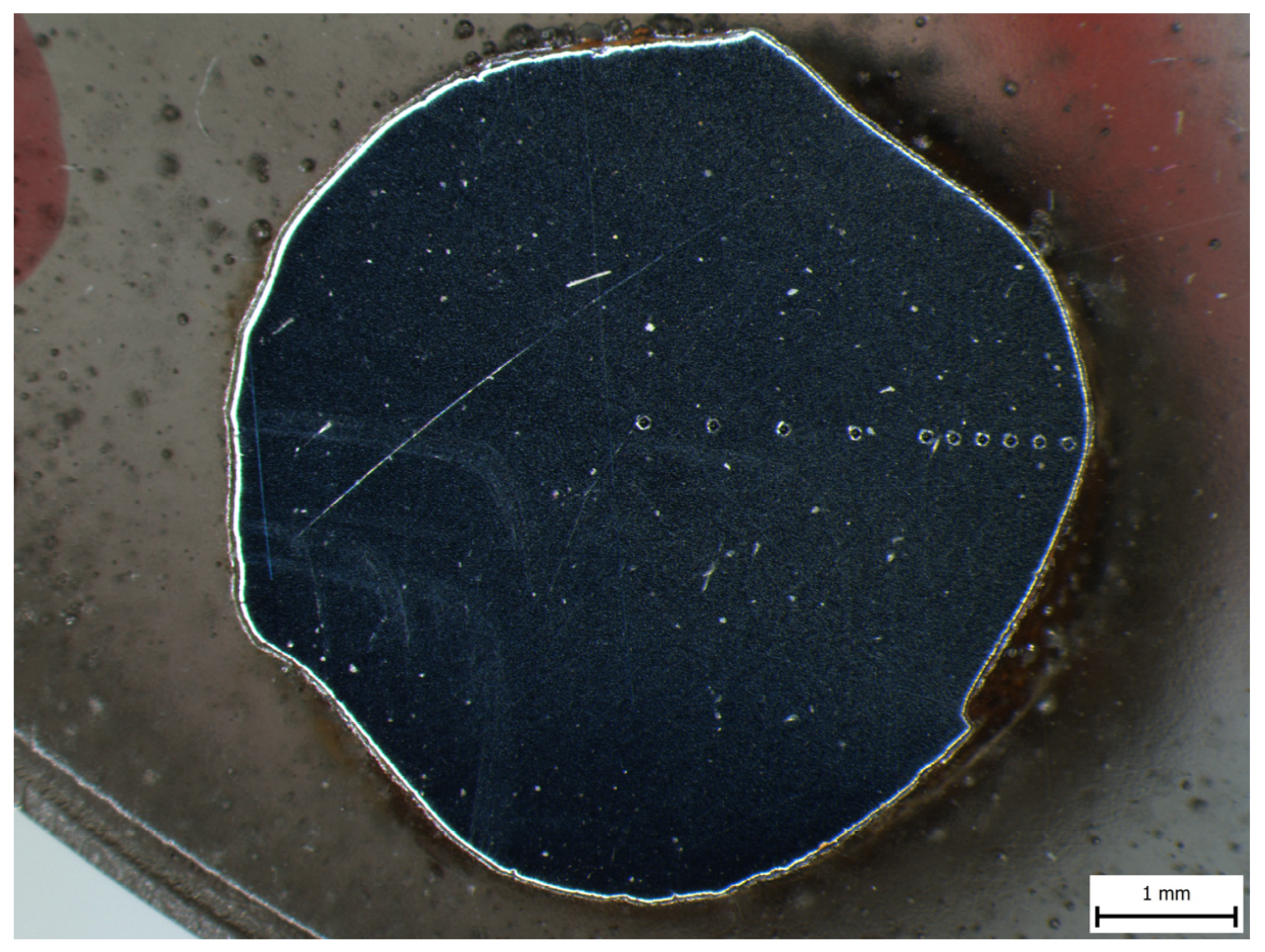

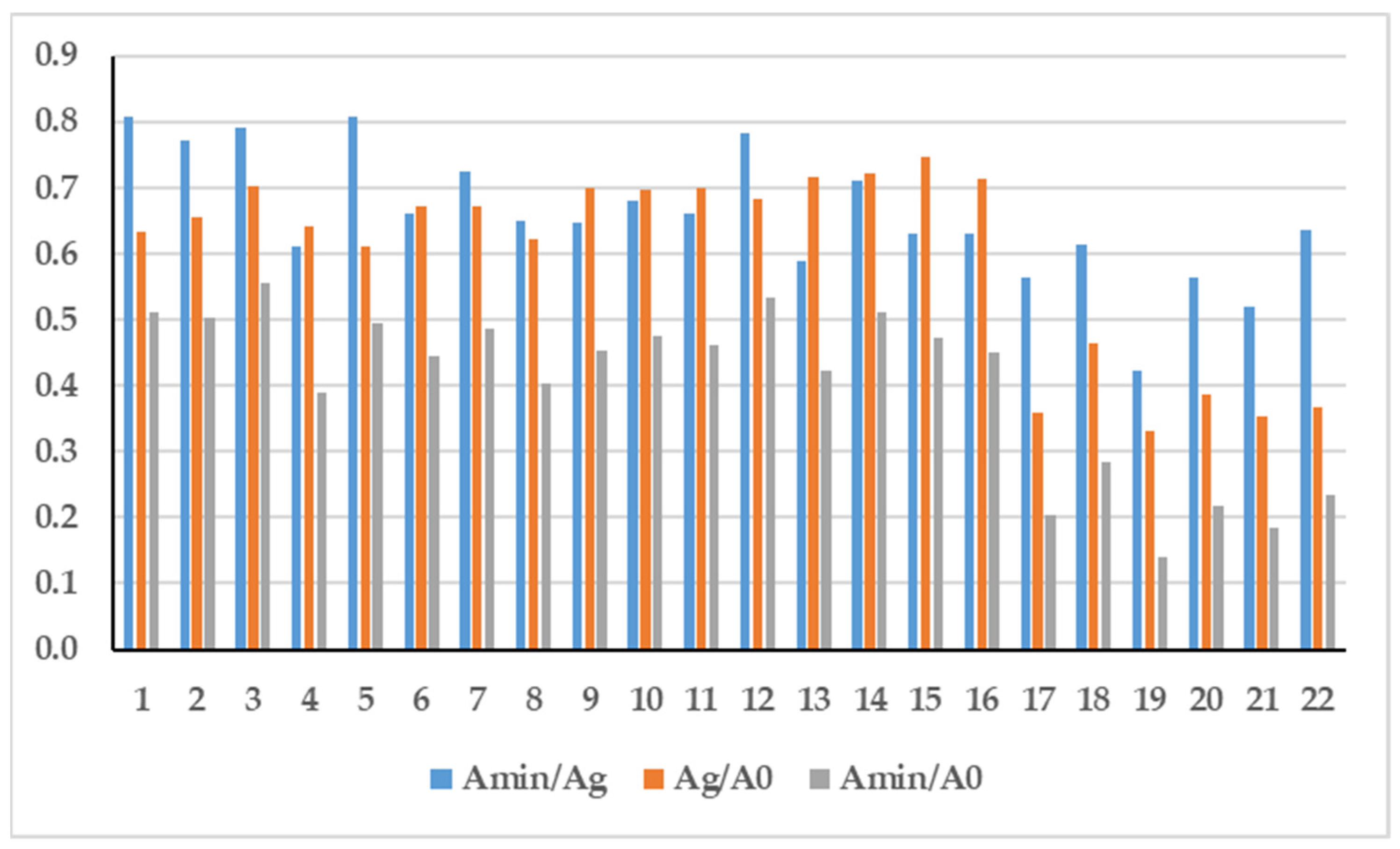

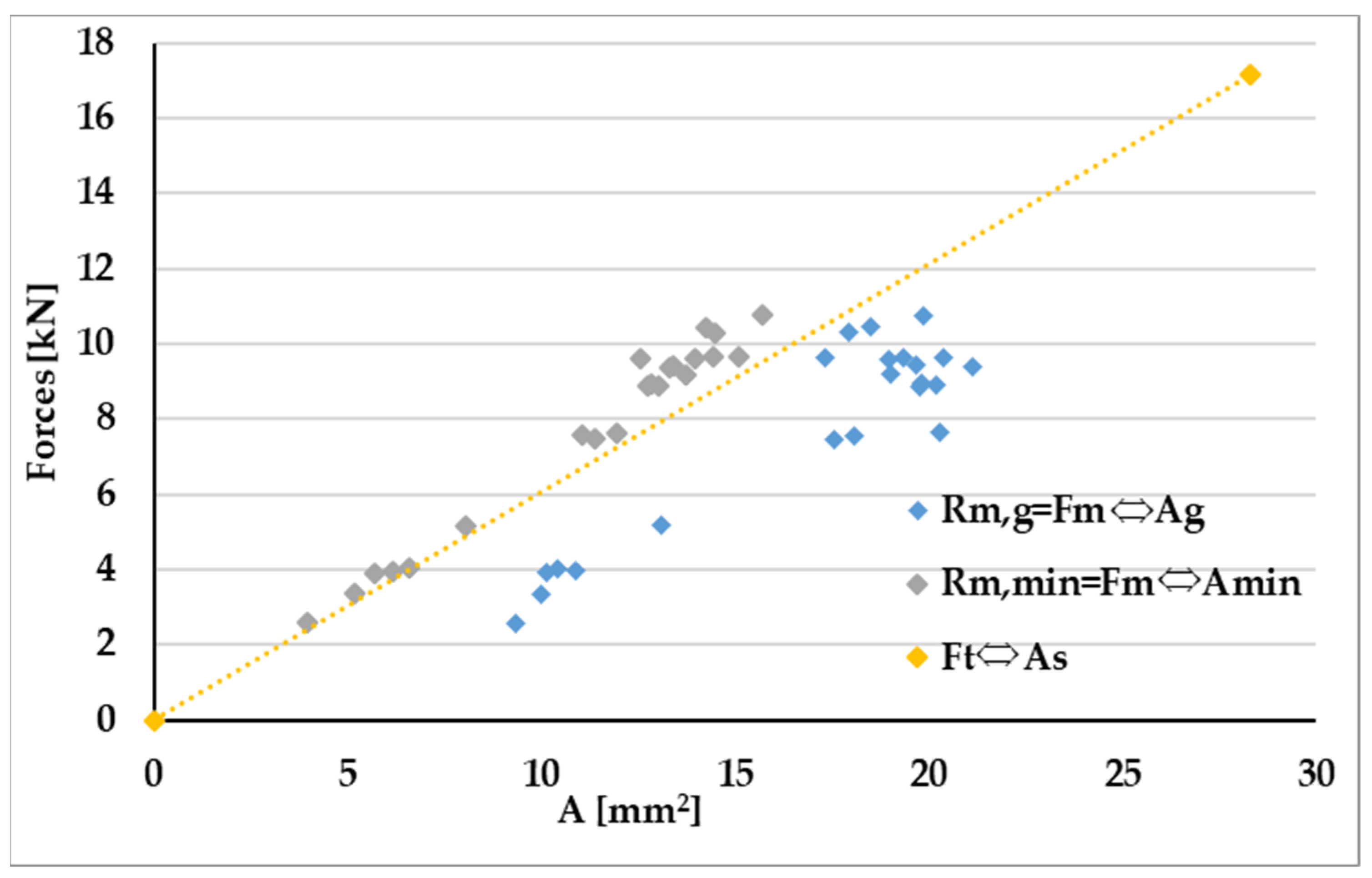
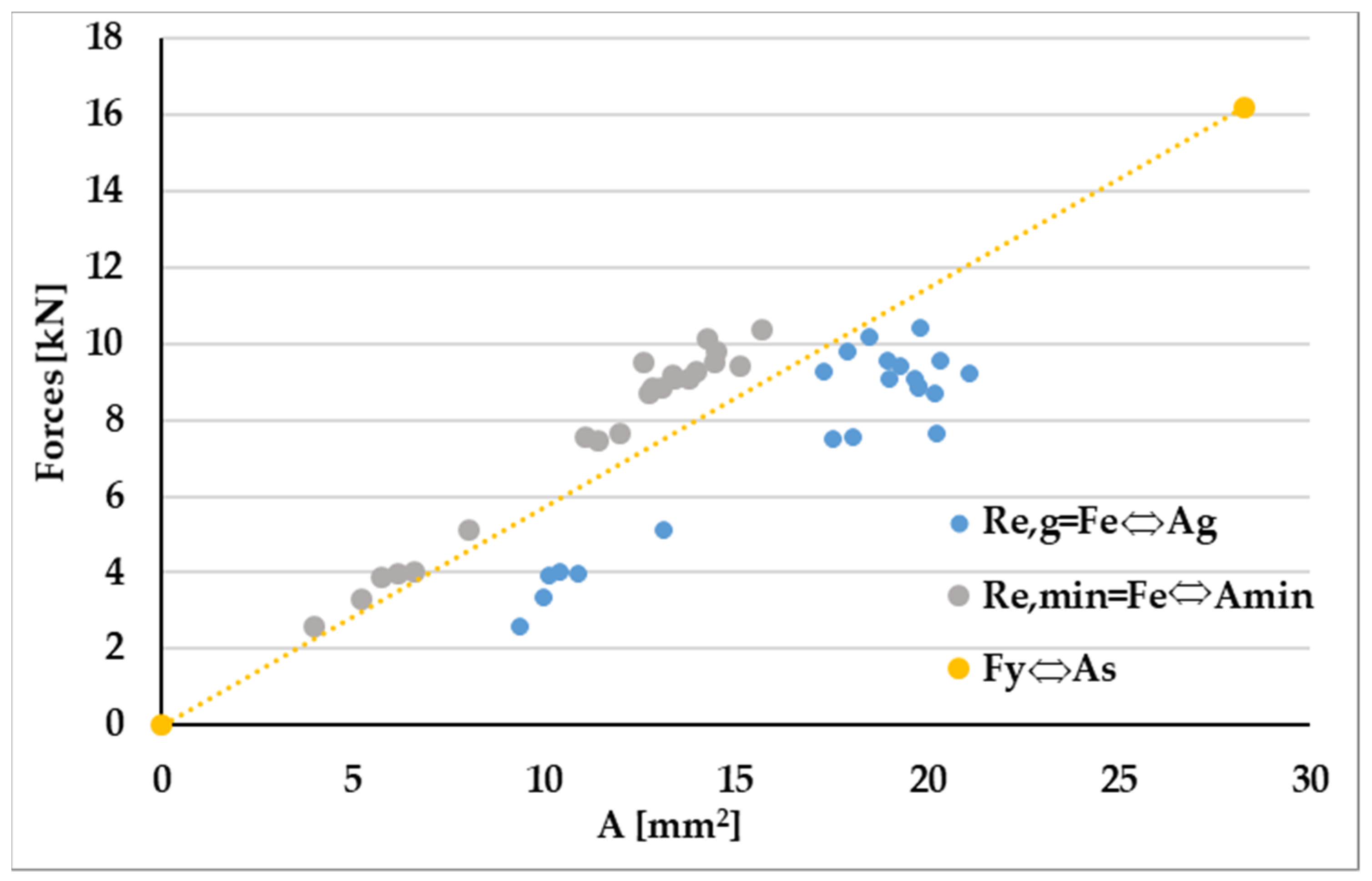
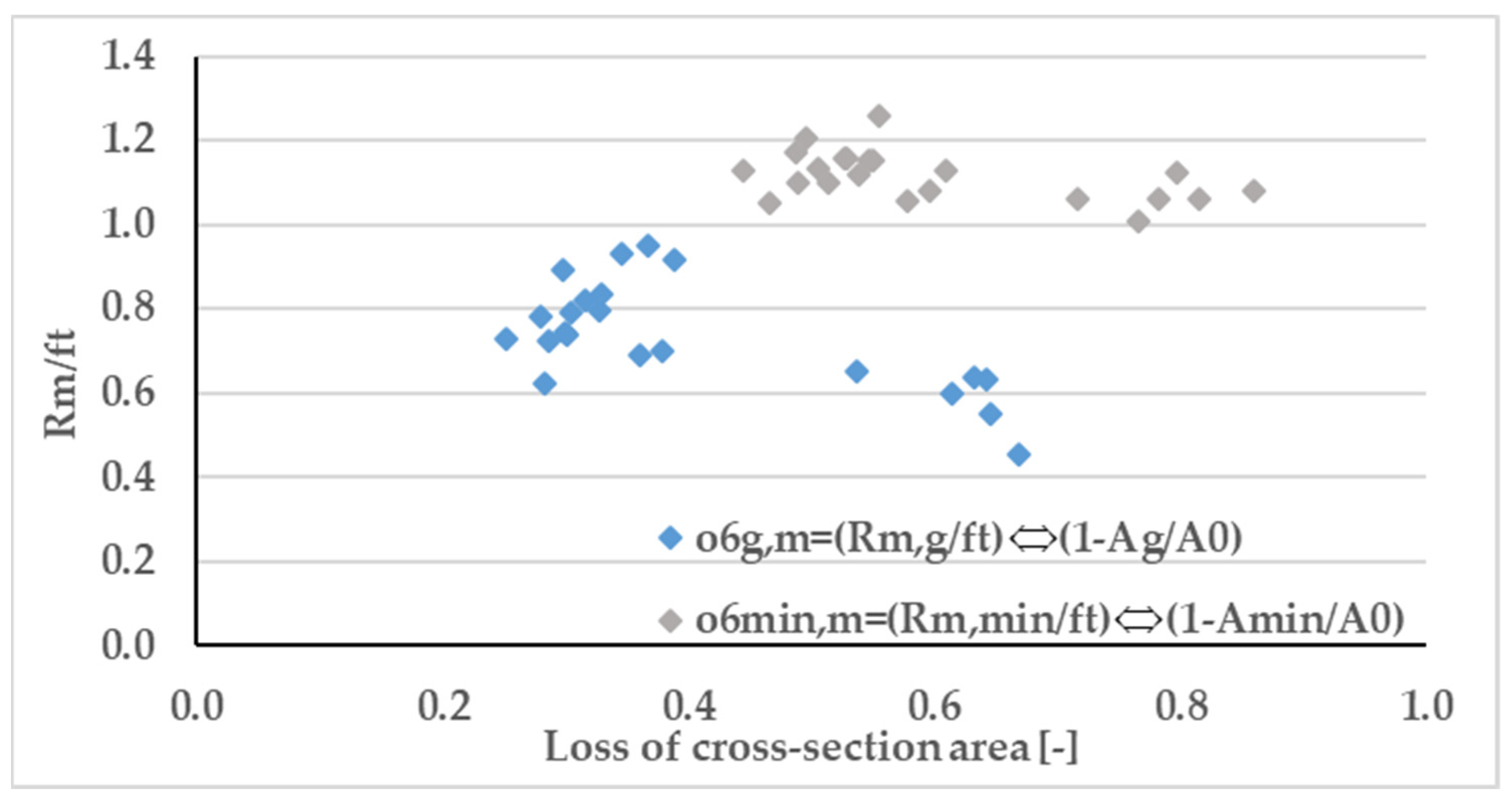

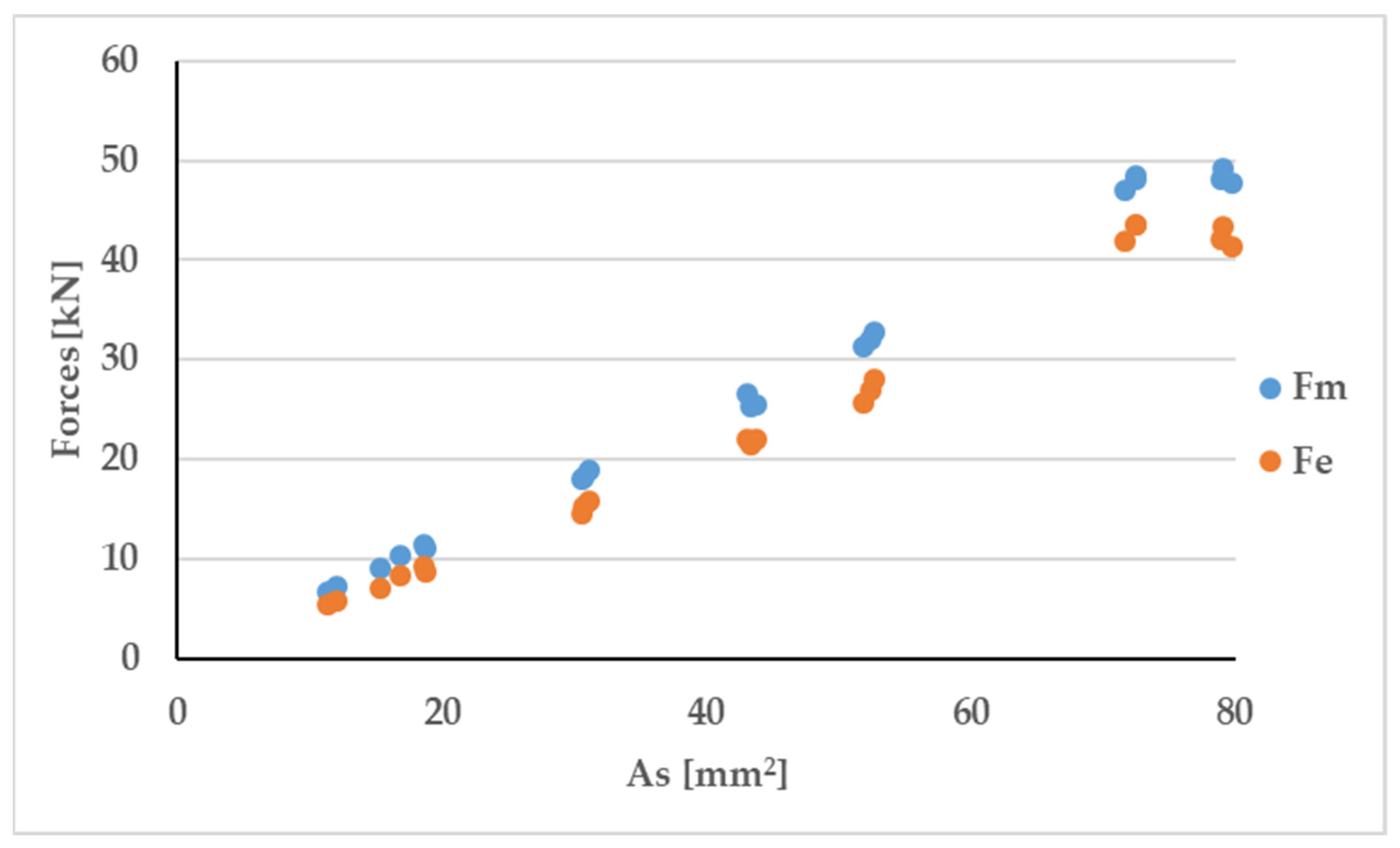

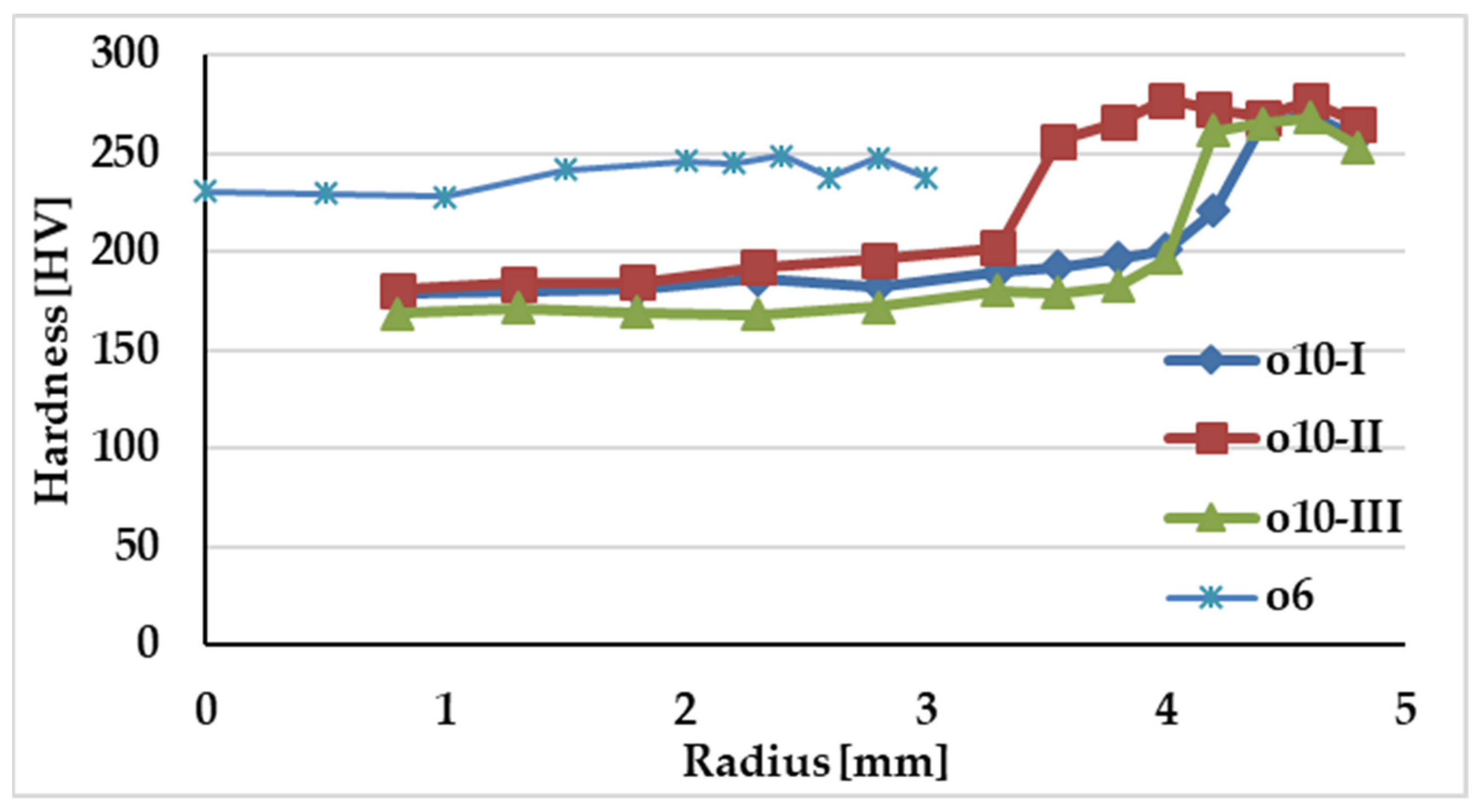
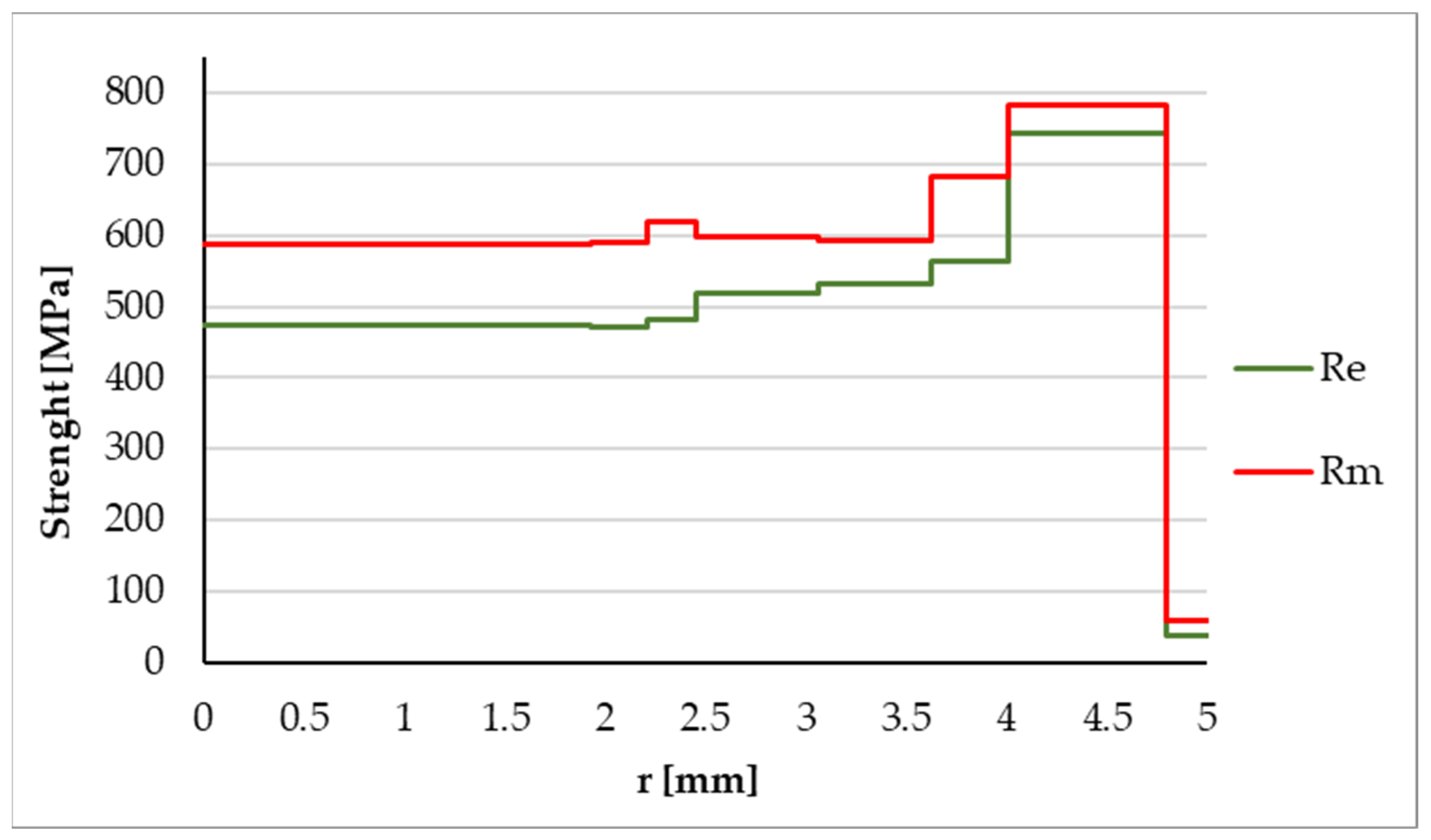


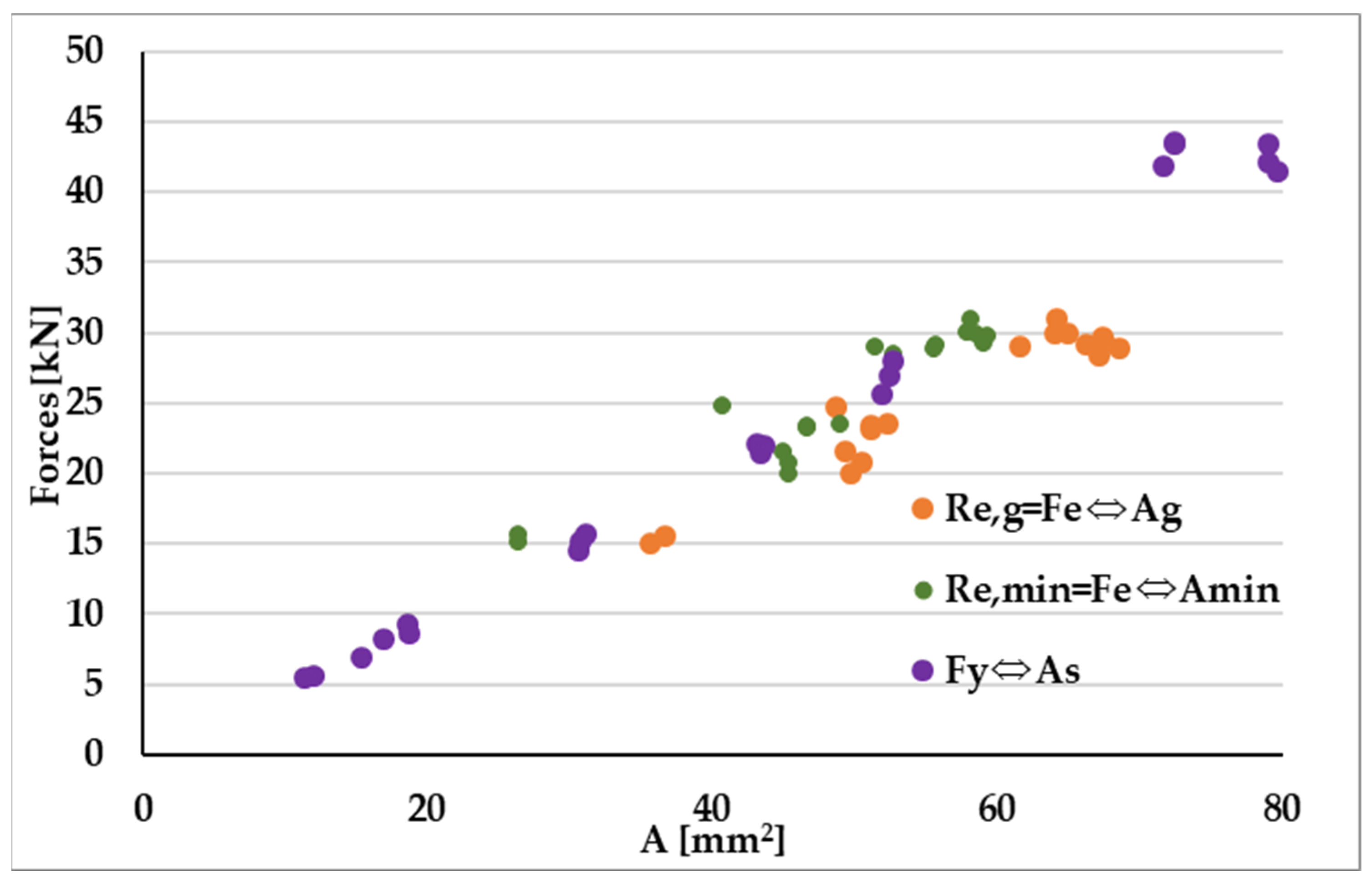
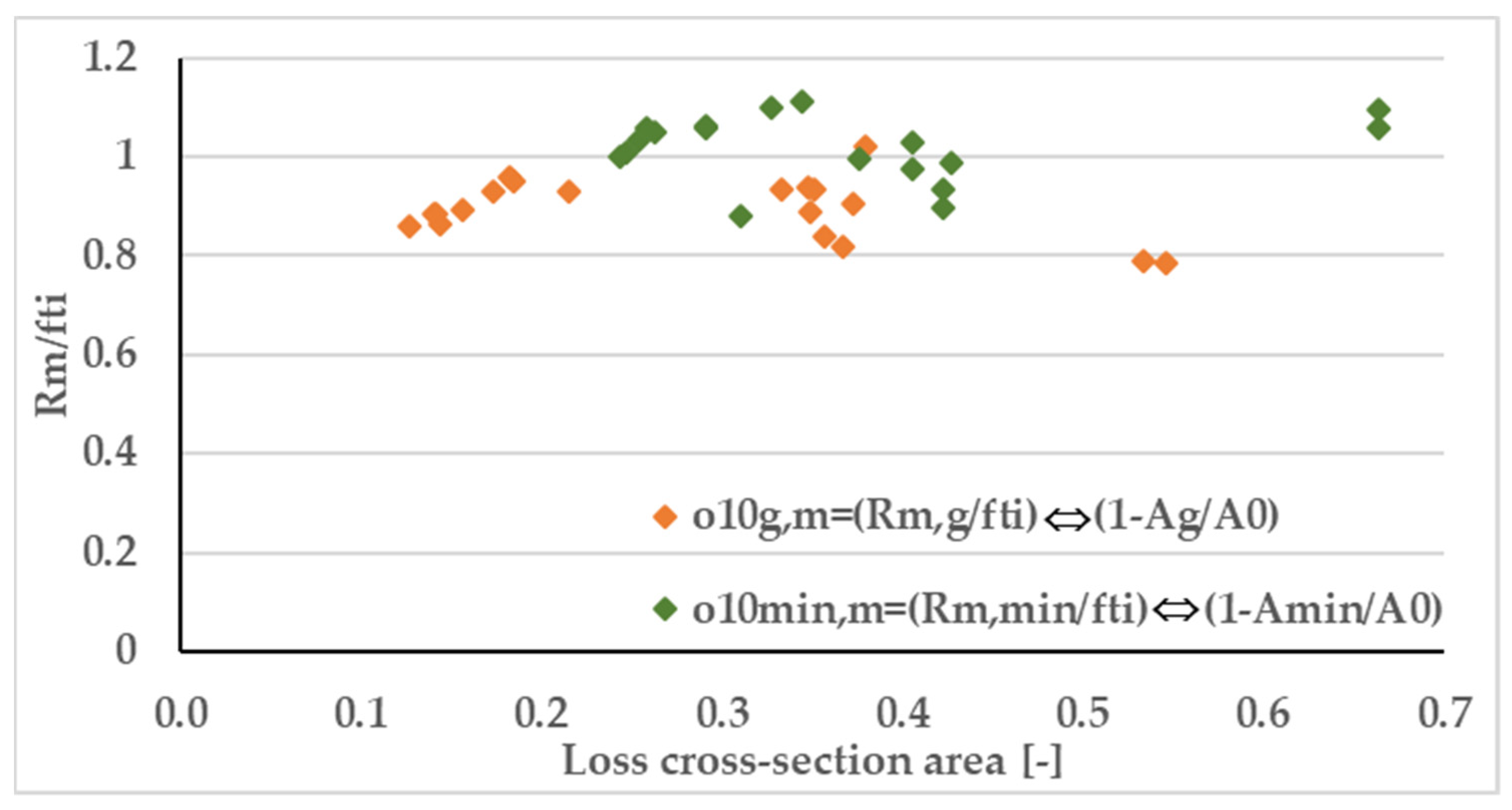

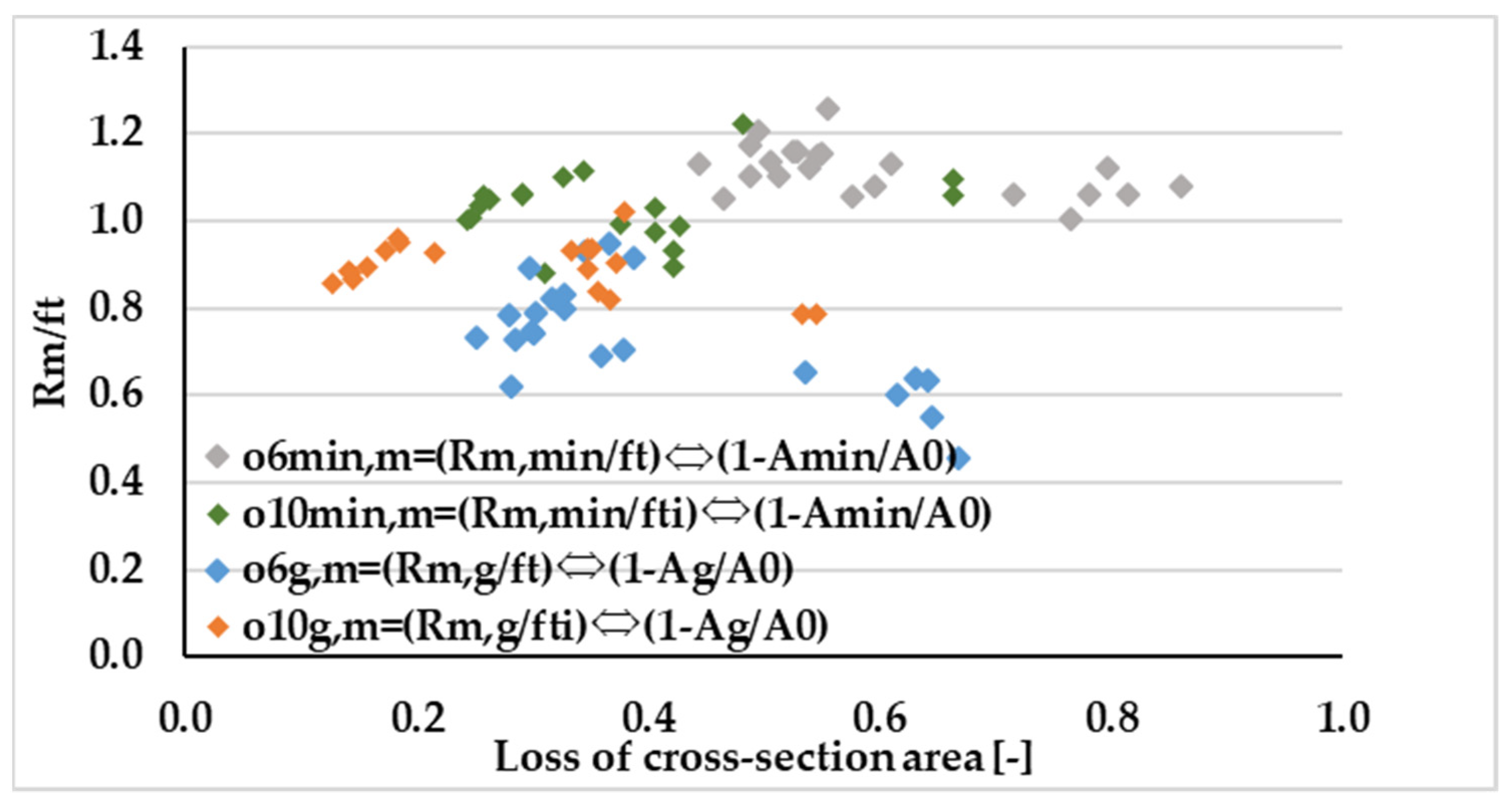
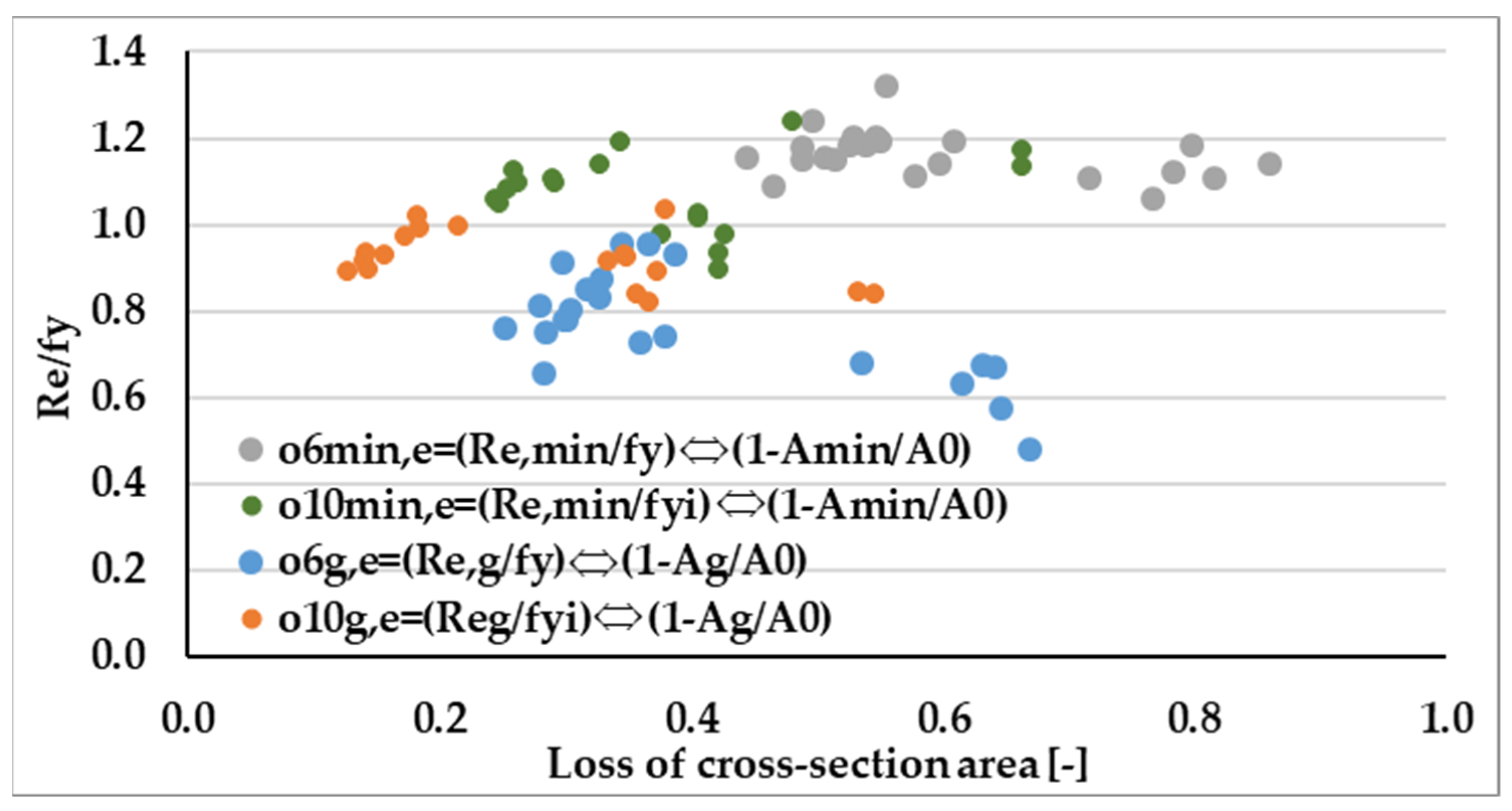

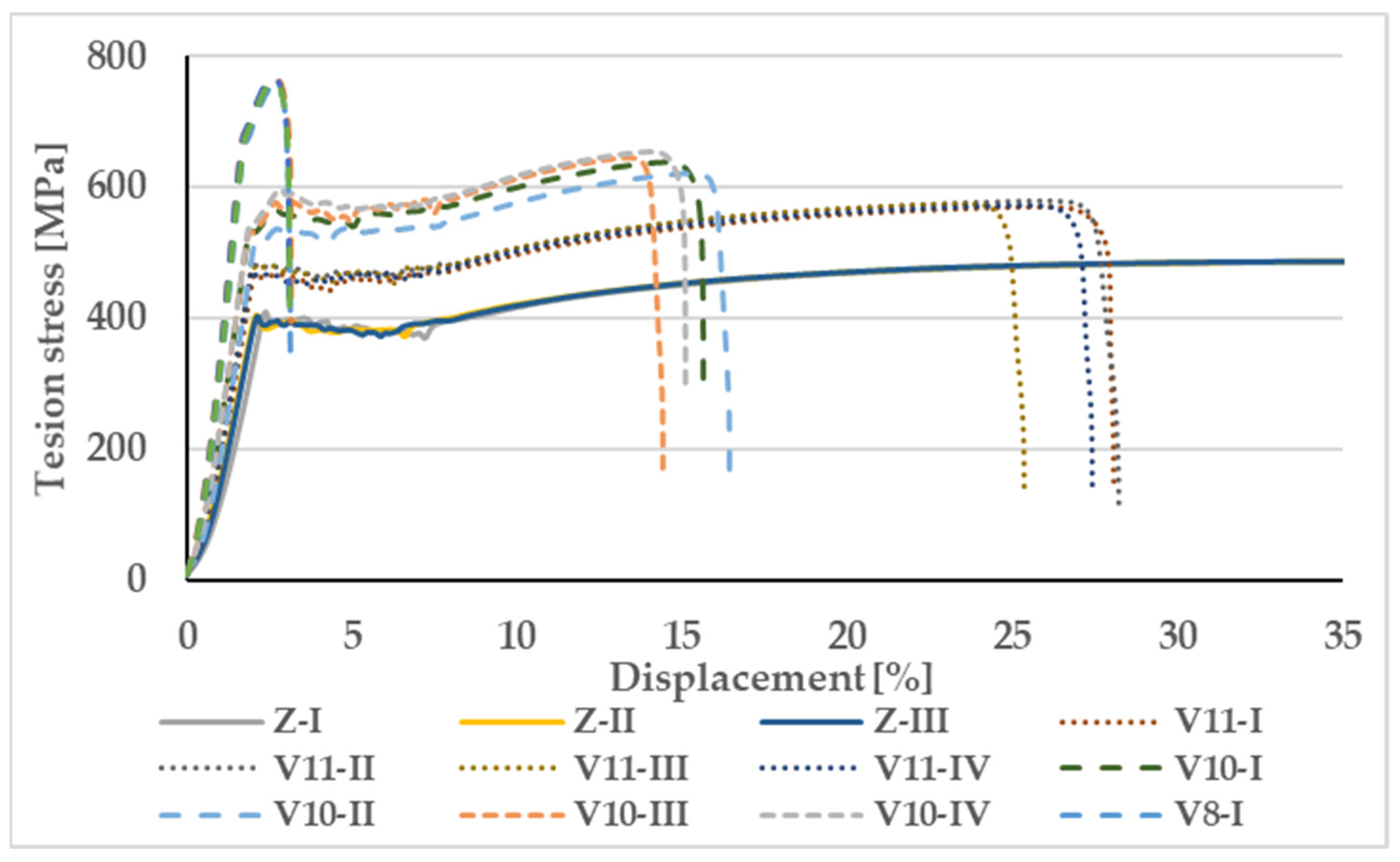
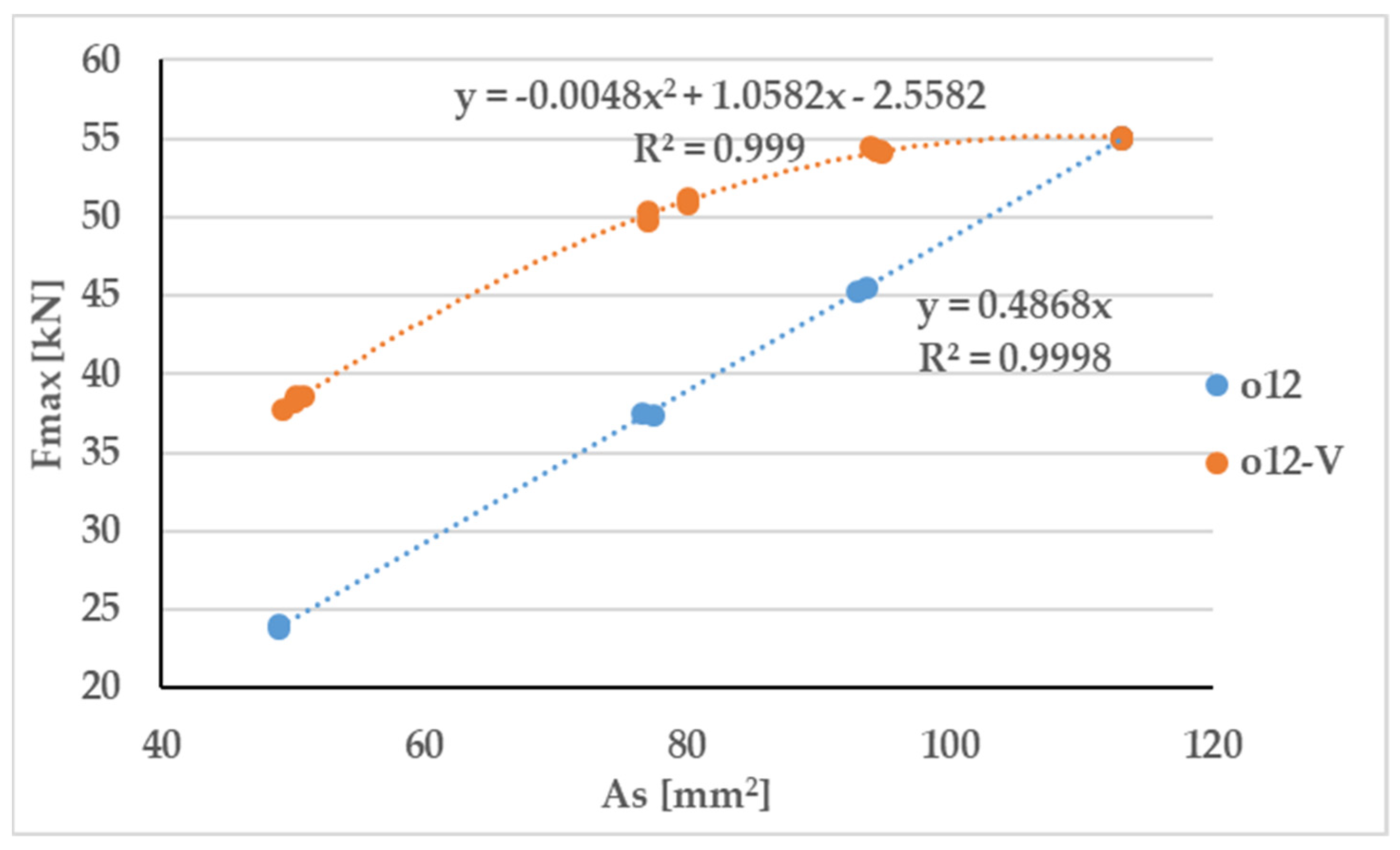
| Characteristics | STN EN 10080 [24] | STN EN 1992-1-1 [8] |
|---|---|---|
| Yield strength | Re | fyk |
| 0.2% proof strength | Rp0.2 | fp0.2k |
| Tensile strength | Rm | ft |
| Ratio of tensile strength to yield strength | Rm/Re | ft/fy |
| Percentage elongation at maximum force | Agt | εu |
| Nominal diameter | d | ϕ |
| ϕ6 n. | m0—Weight before Corrosion [g] | mcorr—Weight after Corrosion [g]—After 62 Days | mcorr—Weight after Corrosion [g]—After 233 Days | α | Fe [kN] | Fm [kN] |
|---|---|---|---|---|---|---|
| 1 | 64.86 | 41.09 | 0.366 | 9.797 | 10.30 | |
| 2 | 63.30 | 41.43 | 0.345 | 10.149 | 10.43 | |
| 3 | 60.80 | 42.66 | 0.298 | 10.373 | 10.75 | |
| 4 | 61.65 | 39.46 | 0.360 | 7.542 | 7.57 | |
| 5 | 61.59 | 37.71 | 0.388 | 9.267 | 9.61 | |
| 6 | 62.07 | 41.69 | 0.328 | 9.524 | 9.59 | |
| 7 | 60.18 | 40.47 | 0.328 | 9.078 | 9.19 | |
| 8 | 59.45 | 36.91 | 0.379 | 7.468 | 7.47 | |
| 9 | 56.50 | 39.56 | 0.300 | 8.829 | 8.94 | |
| 10 | 57.67 | 40.15 | 0.304 | 9.073 | 9.42 | |
| 11 | 56.95 | 39.81 | 0.301 | 8.857 | 8.86 | |
| 12 | 55.48 | 37.92 | 0.317 | 9.402 | 9.64 | |
| 13 | 53.00 | 38.02 | 0.283 | 7.627 | 7.64 | |
| 14 | 53.78 | 38.74 | 0.280 | 9.515 | 9.65 | |
| 15 | 53.16 | 39.75 | 0.252 | 9.197 | 9.37 | |
| 16 | 53.55 | 38.27 | 0.285 | 8.698 | 8.89 | |
| 17 | 63.98 | 22.94 | 0.641 | 3.888 | 3.90 | |
| 18 | 65.04 | 30.18 | 0.536 | 5.099 | 5.18 | |
| 19 | 64.98 | 21.51 | 0.669 | 2.586 | 2.59 | |
| 20 | 64.36 | 24.80 | 0.615 | 3.965 | 3.96 | |
| 21 | 64.20 | 22.74 | 0.646 | 3.305 | 3.35 | |
| 22 | 64.14 | 23.60 | 0.632 | 4.019 | 4.03 |
| ϕ10 n. | m0—Weight before Corrosion [g] | mcorr—Weight after Corrosion [g]—After 62 Days | mcorr—Weight after Corrosion [g]—After 233 Days | mcorr—Weight after Corrosion [g]—After 296 Days | α | Fe [kN] | Fm [kN] |
|---|---|---|---|---|---|---|---|
| 1 | 185.63 | 84.23 | 0.546 | 15.04 | 16.65 | ||
| 2 | 185.86 | 86.71 | 0.533 | 15.57 | 17.20 | ||
| 3 | 183.60 | 144.06 | 0.215 | 28.99 | 33.74 | ||
| 4 | 184.98 | 151.12 | 0.183 | 30.94 | 36.25 | ||
| 5 | 182.01 | 150.46 | 0.173 | 29.91 | 35.63 | ||
| 6 | 182.40 | 148.62 | 0.185 | 29.98 | 35.83 | ||
| 7 | 180.22 | 151.89 | 0.157 | 29.11 | 34.81 | ||
| 8 | 175.41 | 150.42 | 0.142 | 29.73 | 35.01 | ||
| 9 | 172.36 | 148.10 | 0.141 | 29.27 | 35.13 | ||
| 10 | 172.25 | 147.37 | 0.144 | 28.44 | 34.2 | ||
| 11 | 167.83 | 146.41 | 0.128 | 28.84 | 34.67 | ||
| 12 | 188.08 | 122.62 | 0.348 | 23.38 | 28.63 | ||
| 13 | 187.74 | 116.51 | 0.379 | 24.77 | 29.63 | ||
| 14 | 186.90 | 118.26 | 0.367 | 19.96 | 24.22 | ||
| 15 | 185.65 | 116.47 | 0.373 | 21.53 | 26.52 | ||
| 16 | 185.34 | 119.09 | 0.357 | 20.76 | 25.21 | ||
| 17 | 187.44 | 122.04 | 0.349 | 23.21 | 27.07 | ||
| 18 | 190.17 | 126.67 | 0.334 | 23.52 | 29.04 | ||
| 19 | 185.95 | 120.55 | 0.352 | 23.56 | 28.38 |
Disclaimer/Publisher’s Note: The statements, opinions and data contained in all publications are solely those of the individual author(s) and contributor(s) and not of MDPI and/or the editor(s). MDPI and/or the editor(s) disclaim responsibility for any injury to people or property resulting from any ideas, methods, instructions or products referred to in the content. |
© 2023 by the authors. Licensee MDPI, Basel, Switzerland. This article is an open access article distributed under the terms and conditions of the Creative Commons Attribution (CC BY) license (https://creativecommons.org/licenses/by/4.0/).
Share and Cite
Bahleda, F.; Prokop, J.; Koteš, P.; Wdowiak-Postulak, A. Mechanical Properties of Corroded Reinforcement. Buildings 2023, 13, 855. https://doi.org/10.3390/buildings13040855
Bahleda F, Prokop J, Koteš P, Wdowiak-Postulak A. Mechanical Properties of Corroded Reinforcement. Buildings. 2023; 13(4):855. https://doi.org/10.3390/buildings13040855
Chicago/Turabian StyleBahleda, František, Jozef Prokop, Peter Koteš, and Agnieszka Wdowiak-Postulak. 2023. "Mechanical Properties of Corroded Reinforcement" Buildings 13, no. 4: 855. https://doi.org/10.3390/buildings13040855






